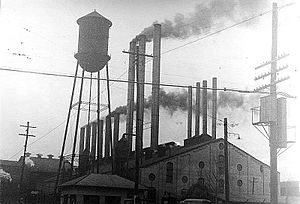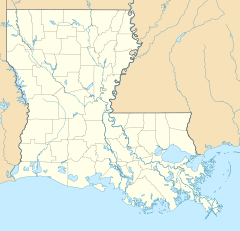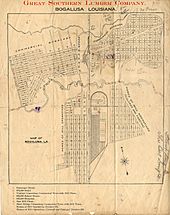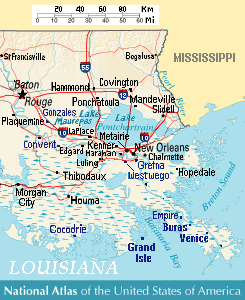Bogalusa, Louisiana facts for kids
Quick facts for kids
Bogalusa, Louisiana
|
|
|---|---|
| City of Bogalusa | |

Great Southern Lumber Company in Bogalusa, 1930s
|
|
| Country | United States |
| State | Louisiana |
| Parish | Washington |
| Incorporated | July 4, 1914 |
| Area | |
| • Total | 9.55 sq mi (24.74 km2) |
| • Land | 9.51 sq mi (24.62 km2) |
| • Water | 0.05 sq mi (0.13 km2) |
| Elevation | 95 ft (29 m) |
| Population
(2020)
|
|
| • Total | 10,659 |
| • Density | 1,121.41/sq mi (432.98/km2) |
| Time zone | UTC-6 (CST) |
| • Summer (DST) | UTC-5 (CDT) |
| Area code(s) | 985 |
| FIPS code | 22-08150 |
| Website | http://www.bogalusa.org |
Bogalusa is a city in Washington Parish, Louisiana, United States. The population was 12,232 at the 2010 census. In the 2020 census the city, town, place equivalent reported a population of 10,659. It is the principal city of the Bogalusa Micropolitan Statistical Area, which includes all of Washington Parish and is also part of the larger New Orleans–Metairie–Hammond combined statistical area.
The name of the city derives from the Choctaw language term bogue lusa, which translates into English as "dark water or "smoky water". Located in an area of pine forests, in the early 20th century, this industrial city was developed as a company town, to provide worker housing and services in association with a Great Southern Lumber Company sawmill. In the late 1930s, this operation was replaced with paper mills and chemical operations.
Contents
History
In 1908, the Great Southern Lumber Company (1908–38) sawmill began operation, and the Goodyear (Frank Henry Goodyear and Charles W. Goodyear) interests of New York built the city of Bogalusa to house workers for the sawmill. William H. Sullivan, the sawmill manager for the Goodyears, was town boss when the city was built (1906–1907) and then mayor until he died on June 26, 1929. The city, designed by New Orleans architect Rathbone DeBuys and built from nothing in less than a year, with several hotels, a YMCA and YWCA, churches of all faiths, and houses for the workers and supervisors, was called the Magic City due to its rapid construction. Bogalusa was incorporated as a city on July 4, 1914. At its peak in 1960, the city had over 21,000 residents.
The Great Southern Lumber Company's sprawling sawmill produced up to 1,000,000 board feet (2400 m3) of lumber a day. The sawmill closed in 1938, and was replaced as the city's main industry by a paper mill and a chemical plant run by Gaylord Container Corporation. The Crown Zellerbach Corporation acquired Gaylord's operations in 1955. An attempt to keep the sawmill open with California redwood proved too costly, and the mill was closed. Crown Zellerbach was the target of a hostile takeover in 1985, and the succeeding company for its container division was a new Gaylord Container Corporation, which operated for 16 years until acquired by Temple-Inland in 2002.
In the mid-1960s, Bogalusa was a center of activity for the Deacons for Defense and Justice.
In 1995 a railroad tank car imploded at Gaylord Chemical Corporation, releasing nitrogen tetroxide and forcing the evacuation of about 3,000 people within a one-mile (1.6 km) radius. Residents say "the sky turned orange" as a result. Emergency rooms filled with about 4,000 people who complained of burning eyes, skin, and lungs. Dozens of lawsuits were filed against Gaylord Chemical and were finally settled in May 2005, with compensation checks issued to around 20,000 people involved in the accident.
On August 29, 2005, Hurricane Katrina hit the city with winds of about 110 mph (175 km/h)*, downing numerous trees and power lines. Many buildings in Bogalusa received damage from falling trees, and several were destroyed. Most of the houses, businesses, and other buildings suffered roof damage from the storm's ferocious winds. Some outlying areas of the city were without power for over a month.
Geography
Bogalusa has an elevation of 100 feet (30.5 m).
According to the United States Census Bureau, the city has a total area of 9.5 square miles (24.6 km2), of which, 9.5 square miles (24.6 km2) is land and 0.1 square miles (0.3 km2) (0.52%) is water.
Demographics
| Historical population | |||
|---|---|---|---|
| Census | Pop. | %± | |
| 1920 | 8,245 | — | |
| 1930 | 14,029 | 70.2% | |
| 1940 | 14,604 | 4.1% | |
| 1950 | 17,798 | 21.9% | |
| 1960 | 21,423 | 20.4% | |
| 1970 | 18,412 | −14.1% | |
| 1980 | 16,976 | −7.8% | |
| 1990 | 14,280 | −15.9% | |
| 2000 | 13,365 | −6.4% | |
| 2010 | 12,232 | −8.5% | |
| 2020 | 10,659 | −12.9% | |
| U.S. Decennial Census | |||
2020 census
| Race | Number | Percentage |
|---|---|---|
| White (non-Hispanic) | 4,410 | 41.37% |
| Black or African American (non-Hispanic) | 5,398 | 50.64% |
| Native American | 23 | 0.22% |
| Asian | 68 | 0.64% |
| Other/Mixed | 356 | 3.34% |
| Hispanic or Latino | 404 | 3.79% |
As of the 2020 United States census, there were 10,659 people, 4,874 households, and 2,923 families residing in the city.
Economy
Bogalusa's economy has been linked to lumbering and its byproducts since the city's founding by the Great Southern Lumber Company chartered in 1902 by the Goodyears of Buffalo, New York. The sawmill was, for many years, the largest in the world. A paper mill was added in 1918. By 1938, the Goodyear family's mill had clear cut all the virgin longleaf yellow pine within hundreds of miles of Bogalusa and after an unprofitable effort to import redwood from California, their sawmill operations at the Great Southern Lumber Company also ended. Bogalusa's industry then shifted to paper milling as Goodyear's sawmill passed onto Gaylord Container Corporation which was then bought by Crown Zellerbach in 1955. By the mid 1960s the mill was producing some 1300 tons of paper daily with four machines. Georgia Pacific acquired the mill in 1986. Its brown paper successor owned the Bogalusa mill until 2002 when Gaylord was acquired by Temple-Inland Corporation, the area's largest employer.
The spill-over of industrial products into the Pearl River in August 2011 resulted in Federal fines of over one million dollars. The following year, 2012, Temple-Inland was acquired by International Paper headquartered in Memphis, TN and the mill came under new ownership. The Bogalusa mill still operates as a corrugated fiberboard plant making boxes and shipping containers. As of 2019 the plant remains the city's largest employer with 425 people. However production is much less than the 1960s with only two machines now in operation.
Education
Bogalusa operates its own public school system, Bogalusa City Schools, consisting of seven elementary schools, one junior high and one high school. As of 2020 there are over 3600 students enrolled and almost 230 teachers working for the district.
Northshore Technical Community College is located in Bogalusa. In 1930, it was the first trade school established in the state of Louisiana, and it is now a fully accredited community college.
Infrastructure
Highways
Bogalusa is located at the juncture of Louisiana Highways ![]() 10 running east–west and
10 running east–west and ![]() 21 running north–south.
21 running north–south.
Rail
There is no passenger rail to Bogalusa but the Bogalusa Bayou Railroad (BBAY) serves Bogalusa's International Paper plant connecting it northward with the Canadian National line in Mississippi.
Air
The Bogalusa Airport, officially named the George R. Carr Memorial Air Field is owned by the city. It is located north of the city.
Notable people
- Kenderick Allen, NFL defensive lineman 2003-08
- Perry Brooks (1954–2010), football defensive tackle, Washington Redskins (1977–1984), Super Bowl XVII champion
- Jacob Brumfield (born in 1965 in Bogalusa), professional baseball outfielder from 1992 to 1999
- Al Clark, NFL player 1971-76
- James Crutchfield (1912–2001), barrelhouse blues piano player; raised in Bogalusa
- Rodney Foil (1934-2018), forestry researcher, educator, and administrator at Mississippi State University.
- Bob Hicks, civil rights activist. See above.
- Trumaine Johnson, Grambling and professional football player; born in Bogalusa
- Yusef Komunyakaa (born in 1947 in Bogalusa), winner of 1994 Pulitzer Prize for Poetry; born James Willie Brown, Jr.
- Skip Manning (1934-), 1976 NASCAR Winston Cup Rookie of the Year
- John McGeever, NFL cornerback 1962-66
- Beth Mizell (born in 1952 in Bogalusa), state senator for Washington Parish
- Henry "Tank" Powell, represented Tangipahoa Parish in state legislature 1996–2008; member of Louisiana Board of Pardons
- Professor Longhair (1918-1980), funky pianist who inspired artists such as Dr. John; several of his songs are Mardi Gras anthems
- Snoozer Quinn (1907–1949), pioneer of jazz guitar; raised in Bogalusa
- Jared Y. Sanders, Sr., former governor, arranged tax breaks for GSL and helped the sawmill with startup
- Jared Y. Sanders, Jr., former U.S. representative and state legislator, practiced law in Bogalusa early in 20th Century
- E.S.G., Hip-Hop musician
- JayDaYoungan, Hip-Hop musician
- Robert Benjamin Smith, former defensive end in the National Football League for the Minnesota Vikings and Dallas Cowboys
- Charlie Spikes, the "Bogalusa Bomber"; MLB player 1972–1980, New York Yankees, Cleveland Indians, Detroit Tigers, Atlanta Braves
- Malinda Brumfield White (born 1967), member of Louisiana House of Representatives from Bogalusa
- Dub Williams, New Mexico legislator
See also
 In Spanish: Bogalusa para niños
In Spanish: Bogalusa para niños






